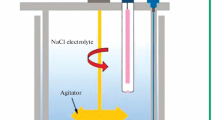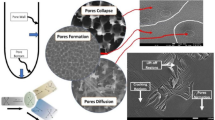Abstract
The electrochemical oscillations that occur during the etching of InP and the three-dimensional (3D) porous structure of the resulting material were studied by performing electrochemical etching in a 3.5 mol L−1 NaCl solution at different temperatures and current densities. The characteristics of the oscillations were modified by adjusting the electrochemical parameters. The relationship between the oscillations and the porous structure of the etched InP was investigated. In the experiments, porous InP with a gradient-index (GI) structure was formed at relatively low temperatures (10–22 °C) and current densities (100–300 mA cm−2). Furthermore, two types of incomplete pores observed in the bottom layer of the porous structure of InP were found to correspond to incomplete oscillations (one-quarter and one-half of an oscillation, respectively), which provided useful insight into how pore growth proceeds in the etched InP. Based on the results obtained in this work, the growth mechanism of porous InP is discussed in this article.








Similar content being viewed by others
References
Ebbesen TW, Lezec HJ, Ghaemi HF, Thio T, Wolff PA (1998) Extraordinary optical transmission through sub-wavelength hole arrays. Nature 391(6668):667–669
Genet C, Ebbesen TW (2007) Light in tiny holes. Nature 445(7123):39–46
Liu HT, Lalanne P (2008) Microscopic theory of the extraordinary optical transmission. Nature 452(7188):728–731
Centeno E, Cassagne D (2005) Graded photonic crystals. Opt Lett 30(17):2278–2280
Kurt H, Citrin DS (2007) Graded index photonic crystals. Opt Express 15(3):1240–1253
Wu Q, Gibbons JM, Park W (2008) Graded negative index lens by photonic crystals. Opt Express 16(21):16941–16949
Tan CL, Peng CS, Zhang J, Wang ZB, Petryakov VN, Verevkin YK, Olaizola SM, Berthou T, Tisserand S (2009) Fabricate planar photonic crystal gradient index lens by laser interference lithography. In: 9th Nanotechnology Conf (IEEE NANO), Genoa, Italy, 26–30 July 2009, pp 450–453
Yuan S, Liu YW, He CJ (2009) Simulating of lens effect of graded-index photonic crystals by multiple-scattering method. Acta Opt Sin 29(S2):106–110
Tan CL, Niemi T, Peng CS, Pessa M (2011) Focusing effect of a graded index photonic crystal lens. Opt Commun 284(12):3140–3143
Park JH, Choi WS, Koo HY, Kim DY (2005) Colloidal photonic crystal with graded refractive index distribution. Adv Mater 17(7):879–885
Cakmak AO, Colak E, Caglayan H, Kurt H, Ozbay E (2009) High efficiency of graded index photonic crystal as an input coupler. J Appl Phys 105(10):103708-1–103708-5
Oner BB, Turduev M, Kurt H (2013) High-efficiency beam bending using graded photonic crystals. Opt Lett 38(10):1688–1690
Liang GQ, Mao WD, Pu YY, Zou H, Wang HZ, Zeng ZH (2006) Fabrication of two-dimensional coupled photonic crystal resonator arrays by holographic lithography. Appl Phys Lett 89(4):041902(1-3)
Jalkanen T, Mäkilä E, Suzuki Y-I, Urata T, Fukami K, Sakka T, Salonen J, Ogata YH (2011) Studies on chemical modification of porous silicon-based graded-index optical microcavities for improved stability under alkaline conditions. Adv Funct Mater 22(18):3890–3898
Lee W, Kim J-C, Gosele U (2010) Spontaneous current oscillations during hard anodization of aluminum under potentiostatic conditions. Adv Funct Mater 20(1):21–27
Krischer K (2001) Spontaneous formation of spatiotemporal patterns at the electrodeǀelectrolyte interface. J Electroanal Chem 501(1–2):1–21
Flätgen G, Krischer K, Ertl G (1996) Spatial-temporal pattern formation during the reduction of peroxodisulfate in the bistable and oscillatory regime: a surface plasmon microscopy study. J Electroanal Chem 409(1–2):183–194
Orlik M (2009) Self-organization in nonlinear dynamical systems and its relation to the materials science. J Solid State Electrochem 13(2):245–261
Weng ZK, Yuan AG, Mi WX, Zhang WD, Wu CT, Wang ZB (2013) Growth of porous InP: transition from three to two dimensional structures. In: Int Conf on Manipulation, Manufacturing and Measurement on the Nanoscale, Suzhou, China, 26–30 Aug 2013, pp 393–396
Chai XY, Xu LP, Deng DD, Zhang ZA, Li L, Weng ZK, Xu HM, Wang ZB (2014) Tunable oscillatory phenomenon during anodic of n-InP(100) by the CPCR model. In: Int Conf on Manipulation, Manufacturing and Measurement on the Nanoscale, Taipei, Taiwan, 27–31 Oct 2014, pp 347–350
Chai XY, Weng ZK, Xu LP, Wang ZB (2015) Tunable electrochemical oscillation and regular 3D nanopore arrays of InP. J Electrochem Soc 162(9):E129–E133
Weng ZK, Liu AM, Sang YC, Zhang JQ, Hu ZQ, Liu YH, Liu WF (2009) Anodic etching of InP using neutral NaCl electrolyte. J Porous Mater 16(6):707–713
Föll H, Langa S, Carstensen J, Christophersen M, Tiginyanu IM (2003) Pores in III–V semiconductors. Adv Mater 15(3):183–198
Parkhutik V, Matveeva E, Perez R, Alamo J, Beltrán D (2000) Mechanism of large oscillations of anodic potential during anodization of silicon in H3PO4/HF solutions. Mater Sci Eng B 69–70:553–558
Quill N, Lynch RP, O’Dwyer C, Buckley DN (2013) Pore formation in InP anodized in KOH: effect of temperature and concentration. ECS Trans 50(37):131–141
Liu AM, Duan CK (2001) Radiative recombination and filling effects of surface states in porous InP. Appl Phys Lett 78(1):43–45
Zeng AS, Zheng MJ, Ma L, Shen WZ (2006) Formation of uniform and square nanopore arrays on (100)InP surfaces by a two-step etching method. Nanotechnology 17(16):4163–4167
Brett CMA, Brett AMO (1993) Electrochemistry principles, methods, and applications. Oxford University Press, Oxford
Acknowledgments
This work was supported by the National Natural Science Foundation Program of China (nos. 61176002 and 11103047), The Education Department of Jilin Province (no. JJKHZ-2015-67), Jilin Provincial Science and Technology Program (nos. 20140414009GH, 20140622009JC, 20160520101JH, 20160101318JC, and 20160623002TC), the National Key Basic Research Program of China (no. 2012CB326406), EU H2020 (no. 644971), and the International Science and Technology Cooperation Program of China (no. 2012DFA11070).
Author information
Authors and Affiliations
Corresponding author
Rights and permissions
About this article
Cite this article
Weng, Z., Chai, X., Liu, L. et al. Effects of temperature and current density on the porous structure of InP. J Solid State Electrochem 21, 545–553 (2017). https://doi.org/10.1007/s10008-016-3387-0
Received:
Revised:
Accepted:
Published:
Issue Date:
DOI: https://doi.org/10.1007/s10008-016-3387-0




